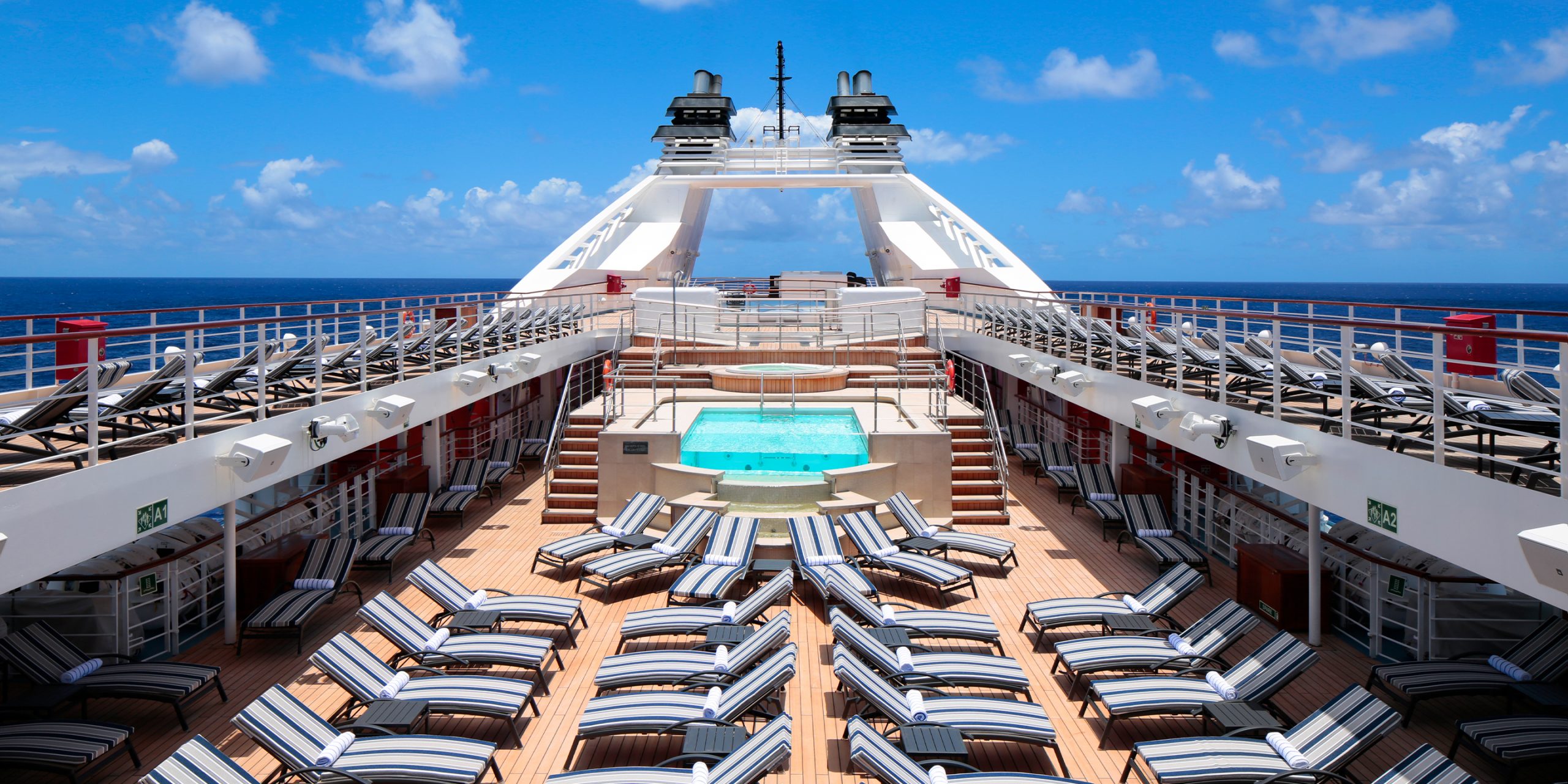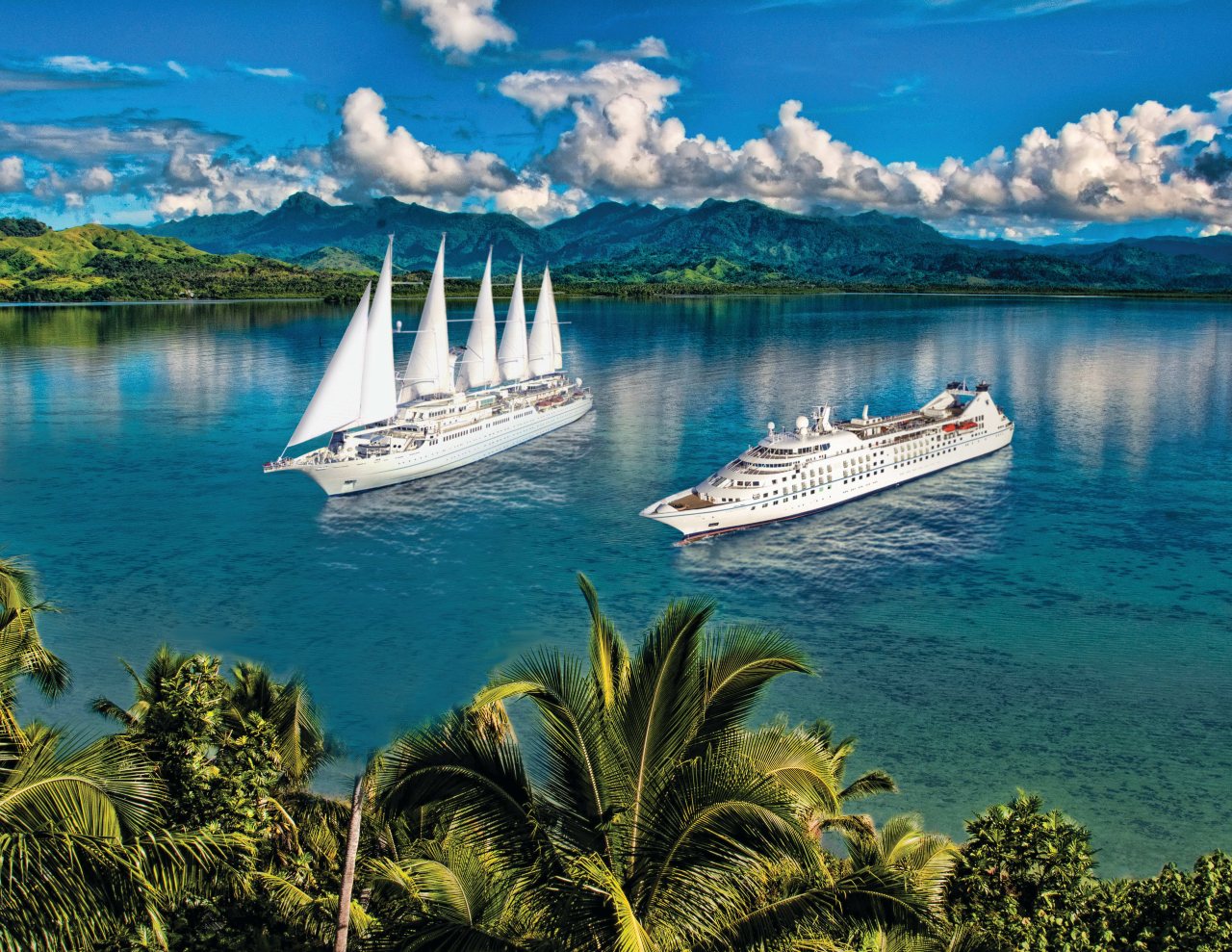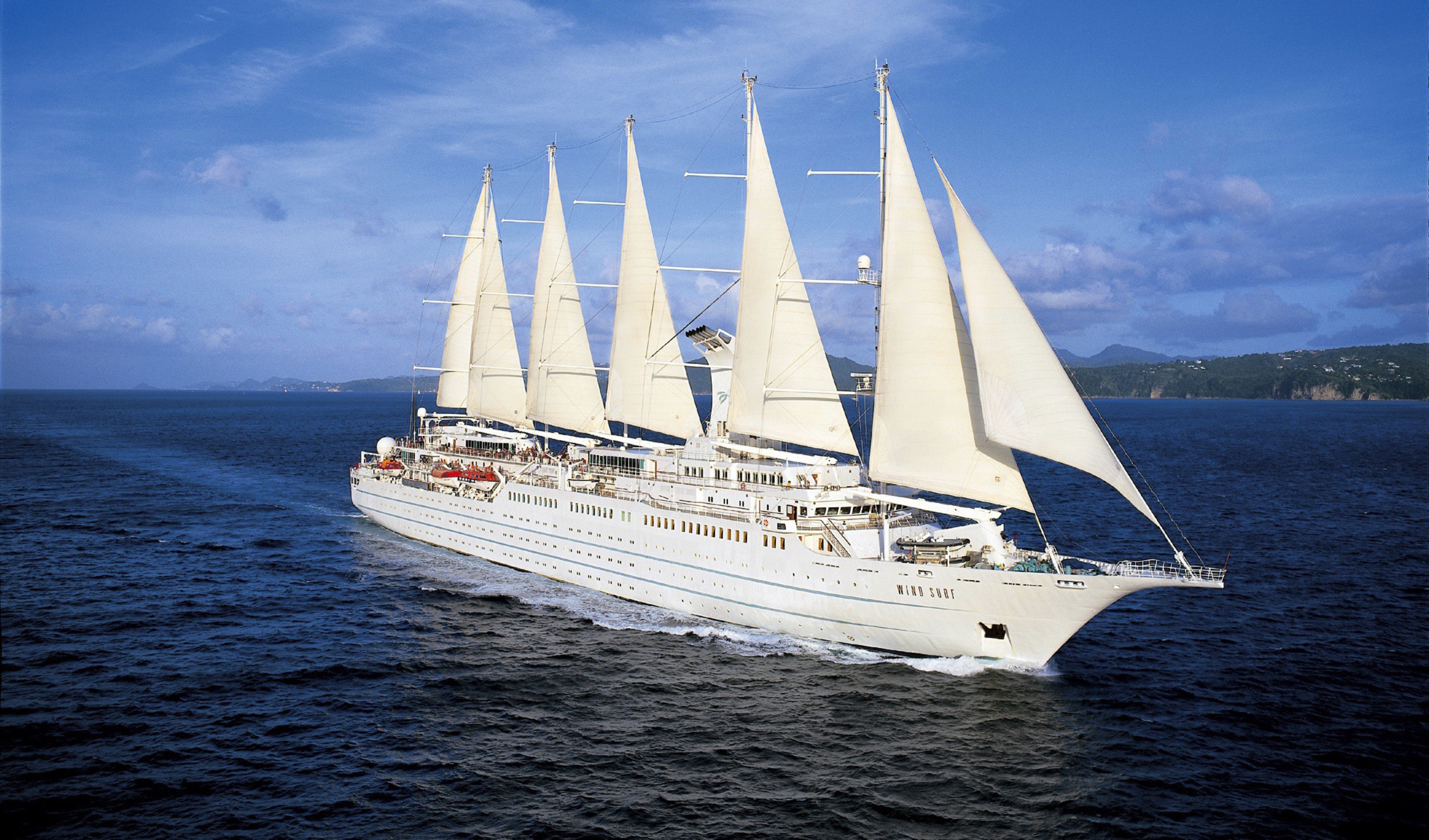Itinerary
Rome, Italy, the Eternal City, is a stunning blend of ancient history and vibrant modern life. Iconic landmarks like the Colosseum, Vatican City, and the Pantheon showcase its glorious past. Cobblestone streets lead to charming piazzas, bustling markets, and world-renowned museums. Rome’s culinary scene delights with traditional Italian cuisine and lively cafes. The city’s rich culture, impressive architecture, and warm, welcoming atmosphere make it an unforgettable destination for travellers.
Day itinerary:
In this enchanting city the past and present intersect in perfect harmony. Casually intermingled among ancient ruins and majestic cathedrals are the trappings of a modern metropolis: Skyscrapers,cafes, boutiques selling designer footwear. But of course what you seek first in the heart of Rome is its breathtaking history. A good place to begin is the Vatican, with its Sistine Chapel and St. Peter’s Basilica. Works by Bernini, Michelangelo, Caravaggio, and Raphael are just a few of those on display, any one of which is worth hours of contemplation. Then the ancient ruins—Colosseum, Forum, Circus Maximus. And of course the Trevi Fountain for the obligatory coins promising your return to the Eternal City.
Sorrento may have become a jumping-off point for visitors to Pompeii, Capri, and Amalfi, but you can find countless reasons to love it for itself. The Sorrentine people are fair-minded and hardworking, bubbling with life and warmth. The tuff cliff on which the town rests is spread over the bay, absorbing sunlight, while orange and lemon trees waft their perfume in spring. Winding along a cliff above a small beach and two harbors, the town is split in two by a narrow ravine formed by a former mountain stream. To the east, dozens of hotels line busy Via Correale along the cliff—many have “grand” included in their names, and some indeed still are. To the west, however, is the historic sector, which still enchants. It’s a relatively flat area, with winding, stone-paved lanes bordered by balconied buildings, some joined by medieval stone arches. The central piazza is named after the poet Torquato Tasso, born here in 1544. This part of town is a delightful place to walk through. Craftspeople are often at work in their stalls and shops and are happy to let you watch; in fact, that’s the point. Music spots and bars cluster in the side streets near Piazza Tasso.
Day itinerary:
UNESCO World Heritage Sites abound in Sorrento. Optional tours will take you to the archaeological areas of Pompeii and Torre Annunziata, or the 4th century B.C. city of Herculaneum. Perhaps your choice will be a boat ride to Positano, the legendary home of the Sirens. Perched on a terrace on the spectacular Amalfi Coast, Sorrento offers exceptional views of the Bay of Naples and Mount Vesuvius.
Day itinerary:
Today you’ll discover one of Sicily’s jewels, the charming village of Giardini Naxos, nestled in one of the world’s most beautiful bays. An optional excursion to the popular hillside town of Taormina will be a highlight of your voyage — from the stunning setting of the iconic Greek Theater to the sparkling beaches along the Ionian Sea. Take a more adventurous tack and explore the UNESCO site of Mount Etna, Europe’s most active volcano.
Backed by imposing mountains, tiny Kotor lies hidden from the open sea, tucked into the deepest channel of the Bokor Kotorska (Kotor Bay), which is Europe’s most southerly fjord. To many, this town is more charming than its sister UNESCO World Heritage Site, Dubrovnik, retaining more authenticity, but with fewer tourists and spared the war damage and subsequent rebuilding which has given Dubrovnik something of a Disney feel.Kotor’s medieval Stari Grad (Old Town) is enclosed within well-preserved defensive walls built between the 9th and 18th centuries and is presided over by a proud hilltop fortress. Within the walls, a labyrinth of winding cobbled streets leads through a series of splendid paved piazzas, rimmed by centuries-old stone buildings. The squares are now haunted by strains from buskers but although many now house trendy cafés and chic boutiques, directions are still given medieval-style by reference to the town’s landmark churches.In the Middle Ages, as Serbia’s chief port, Kotor was an important economic and cultural center with its own highly regarded schools of stonemasonry and iconography. From 1391 to 1420 it was an independent city-republic and later, it spent periods under Venetian, Austrian, and French rule, though it was undoubtedly the Venetians who left the strongest impression on the city’s architecture. Since the breakup of Yugoslavia, some 70% of the stone buildings in the romantic Old Town have been snapped up by foreigners, mostly Brits and Russians. Porto Montenegro, a new marina designed to accommodate some of the world’s largest super yachts, opened in nearby Tivat in 2011, and along the bay are other charming seaside villages, all with better views of the bay than the vista from Kotor itself where the waterside is congested with cruise ships and yachts. Try sleepy Muo or the settlement of Prčanj in one direction around the bay, or Perast and the Roman mosaics of Risan in the other direction.
Day itinerary:
This is one of Montenegro’s most beautiful bays, and the approach offers one breathtaking fjord-like view after another. Just when you’ve reached your fill of blues and greens, the bright red rooftops of the medieval Old Town come into view. The entire area has been proclaimed a UNESCO World Heritage Site. The charming streets of Old Town remain car free, filled with 12th century Baroque palaces and Romanesque churches. For a fresh perspective, climb to the fortress on the hill for a breathtaking vista.
Nothing can prepare you for your first sight of Dubrovnik. Lying 216 km (135 miles) southeast of Split and commanding a jaw-dropping coastal location, it is one of the world’s most beautiful fortified cities. Its massive stone ramparts and fortress towers curve around a tiny harbor, enclosing graduated ridges of sun-bleached orange-tiled roofs, copper domes, and elegant bell towers. Your imagination will run wild picturing what it looked like seven centuries ago when the walls were built, without any suburbs or highways around it, just this magnificent stone city rising out of the sea.In the 7th century AD, residents of the Roman city Epidaurum (now Cavtat) fled the Avars and Slavs of the north and founded a new settlement on a small rocky island, which they named Laus, and later Ragusa. On the mainland hillside opposite the island, the Slav settlement called Dubrovnik grew up. In the 12th century the narrow channel separating the two settlements was filled in (now the main street through the Old Town, called Stradun), and Ragusa and Dubrovnik became one. The city was surrounded by defensive walls during the 13th century, and these were reinforced with towers and bastions in the late 15th century.From 1358 to 1808 the city thrived as a powerful and remarkably sophisticated independent republic, reaching its golden age during the 16th century. In 1667 many of its splendid Gothic and Renaissance buildings were destroyed by an earthquake. The defensive walls survived the disaster, and the city was rebuilt in baroque style.Dubrovnik lost its independence to Napoléon in 1808, and in 1815 passed to Austria-Hungary. During the 20th century, as part of Yugoslavia, the city became a popular tourist destination, and in 1979 it was listed as a UNESCO World Heritage Site. During the war for independence, it came under heavy siege. Thanks to careful restoration, few traces of damage remain; however, there are maps inside the Pile and Ploče Gates illustrating the points around the city where damage was done. It’s only when you experience Dubrovnik yourself that you can understand what a treasure the world nearly lost
Day itinerary:
While larger ships must pass by, we anchor right beyond the famous walled city so you can admire its beauty with every glance. Tender ashore and step right into Old Town, a UNESCO site where no cars are allowed, just eons of history. Capture the exhilarating views on your camera — and in your memory. End your day at the Buza Café (if you can find it) watching bold divers leap off the cliffs into the crystalline sea.
Split’s ancient core is so spectacular and unusual that a visit is more than worth your time. The heart of the city lies within the walls of Roman emperor Diocletian’s retirement palace, which was built in the 3rd century AD. Diocletian, born in the nearby Roman settlement of Salona in AD 245, achieved a brilliant career as a soldier and became emperor at the age of 40. In 295 he ordered this vast palace to be built in his native Dalmatia, and when it was completed he stepped down from the throne and retired to his beloved homeland. Upon his death, he was laid to rest in an octagonal mausoleum, around which Split’s magnificent cathedral was built.In 615, when Salona was sacked by barbarian tribes, those fortunate enough to escape found refuge within the stout palace walls and divided up the vast imperial apartments into more modest living quarters. Thus, the palace developed into an urban center, and by the 11th century the settlement had expanded beyond the ancient walls.Under the rule of Venice (1420–1797), Split—as a gateway to the Balkan interior—became one of the Adriatic’s main trading ports, and the city’s splendid Renaissance palaces bear witness to the affluence of those times. When the Habsburgs took control during the 19th century, an overland connection to Central Europe was established by the construction of the Split–Zagreb–Vienna railway line.After World War II, the Tito years saw a period of rapid urban expansion: industrialization accelerated and the suburbs extended to accommodate high-rise apartment blocks. Today the historic center of Split is included on UNESCO’s list of World Heritage Sites.
Day itinerary:
Split welcomes you with open arms, Mediterranean style, and a bustling harbor lined with busy cafés. Beyond, looms stately Diocletian’s Palace a UNESCO World Heritage Site in the center of town. Within the palace walls, a majestic cathedral soars, surrounded by polished marble streets lined with every type of tempting shop. If you’re longing for a quiet respite, head for the western end of town for an easy stroll through a verdant mountain park. Or take an optional tour to Trogir, another UNESCO site.
One of the true jewels of the Mediterranean, Rovinj is a jaw-droppingly beautiful town, which juts out into sparkling Mediterranean. Dominated by the pencil-like bell tower of the Venetian Saint Euphemia Cathedral, pine tree forests flow to the borders of the quaint Old Town – which evokes the romantic, tangled backstreets of the Venice. Rovinj – or Rovino in Italian – is a city of split personalities, with two official languages – having been owned by the Kingdom of Italy between 1919 and 1947.
Day itinerary:
The lovely fishing port of Rovinj on the west coast of the Istrian peninsula bordered on three sides by the Adriatic Sea. You can tour the maze of cobblestone streets that lead to the hilltop St. Euphemia Cathedral with its towering steeple dominating the skyline. Old Town Rovinj is a delightful tangle of medieval streets and twisting stairways. Seek out the Bronze Age ruins of Monkodonja, the hidden beaches or the breathtaking natural beauty of the 6-mile-long Lim Fjord.
Venice is a city unlike any other. No matter how often you’ve seen it in photos and films, the real thing is more dreamlike than you could imagine. With canals where streets should be, water shimmers everywhere. The fabulous palaces and churches reflect centuries of history in what was a wealthy trading center between Europe and the Orient. Getting lost in the narrow alleyways is a quintessential part of exploring Venice, but at some point you’ll almost surely end up in Piazza San Marco, where tourists and locals congregate for a coffee or an aperitif.
Day itinerary:
No other sea approach in the Adriatic raises goose bumps like Venice, a small ship exclusive where the entire city and its lagoon are a UNESCO World Heritage Site. On your luxurious home-away-from home, you arrive already equipped with a sense of what it’s like to live in the city that’s neither land nor water. Add your own sigh to the Bridge of Sighs, sip a spritz al bitter as you plot your agenda, and let the water taxis do your navigating unless you don’t mind getting lost. Not such a bad prospect, with serendipitous discoveries around every corner.
Dalmatia’s capital for more than 1,000 years, Zadar is all too often passed over by travelers on their way to Split or Dubrovnik. What they miss out on is a city of more than 73,000 that is remarkably lovely and lively despite—and, in some measure, because of—its tumultuous history. The Old Town, separated from the rest of the city on a peninsula some 4 km (2½ miles) long and just 1,640 feet wide, is bustling and beautiful: the marble pedestrian streets are replete with Roman ruins, medieval churches, palaces, museums, archives, and libraries. Parts of the new town are comparatively dreary, a testament to what a world war followed by decades of communism, not to mention a civil war, can do to the architecture of a city that is 3,000 years old. A settlement had already existed on the site of the present-day city for some 2,000 years when Rome finally conquered Zadar in the 1st century BC; the foundations of the forum can be seen today. Before the Romans came the Liburnians had made it a key center for trade with the Greeks and Romans for 800 years. In the 3rd century BC the Romans began to seriously pester the Liburnians, but required two centuries to bring the area under their control. During the Byzantine era, Zadar became the capital of Dalmatia, and this period saw the construction of its most famous church, the 9th-century St. Donat’s Basilica. It remained the region’s foremost city through the ensuing centuries. The city then experienced successive onslaughts and occupations—both long and short—by the Osogoths, the Croatian-Hungarian kings, the Venetians, the Turks, the Habsburgs, the French, the Habsburgs again, and finally the Italians before becoming part of Yugoslavia and, in 1991, the independent republic of Croatia. Zadar was for centuries an Italian-speaking city, and Italian is still spoken widely, especially by older people. Indeed, it was ceded to Italy in 1921 under the Treaty of Rapallo (and reverted to its Italian name of Zara). Its occupation by the Germans from 1943 led to intense bombing by the Allies during World War II, which left most of the city in ruins. Zadar became part of Tito’s Yugoslavia in 1947, prompting many Italian residents to leave. Zadar’s most recent ravages occurred during a three-month siege by Serb forces and months more of bombardment during the Croatian-Serbian war between 1991 and 1995. But you’d be hard-pressed to find outward signs of this today in what is a city to behold. There are helpful interpretive signs in English all around the Old Town, so you certainly won’t feel lost when trying to make sense of the wide variety of architectural sites you might otherwise pass by with only a cursory look.
Day itinerary:
Something here will capture your heart. A Roman amphitheater, 9th century churches, and museums packed with Byzantine-era artworks crowd the peninsula that tidily contains the Old Town. It’s a tempting way to spend the day for sure. While away the day listening to Zadar’s giant Sea Organ, a haunting musical improv performed by the surging Adriatic or share a bench with a sun-drunk cat as you bite into a truffle.
The Croatian island of Hvar bills itself as the “sunniest island in the Adriatic.” Not only does it have the figures to back up this claim—an annual average of 2,724 hours of sunshine—but it also makes visitors a sporting proposition, offering them a money-back guarantee if there are seven consecutive days of snow (snow has been known to fall here; the last time being February 2012).
Day itinerary:
Celebrities from Prince Harry to Beyoncé have made Hvar their go-to place. Follow the city walls to sweeping views from the fortress on the hill. Head to the town square for a look at the Venetian Cathedral or find the large bay of Stari Grad on an optional tour to this famous UNESCO site.
Nothing can prepare you for your first sight of Dubrovnik. Lying 216 km (135 miles) southeast of Split and commanding a jaw-dropping coastal location, it is one of the world’s most beautiful fortified cities. Its massive stone ramparts and fortress towers curve around a tiny harbor, enclosing graduated ridges of sun-bleached orange-tiled roofs, copper domes, and elegant bell towers. Your imagination will run wild picturing what it looked like seven centuries ago when the walls were built, without any suburbs or highways around it, just this magnificent stone city rising out of the sea.In the 7th century AD, residents of the Roman city Epidaurum (now Cavtat) fled the Avars and Slavs of the north and founded a new settlement on a small rocky island, which they named Laus, and later Ragusa. On the mainland hillside opposite the island, the Slav settlement called Dubrovnik grew up. In the 12th century the narrow channel separating the two settlements was filled in (now the main street through the Old Town, called Stradun), and Ragusa and Dubrovnik became one. The city was surrounded by defensive walls during the 13th century, and these were reinforced with towers and bastions in the late 15th century.From 1358 to 1808 the city thrived as a powerful and remarkably sophisticated independent republic, reaching its golden age during the 16th century. In 1667 many of its splendid Gothic and Renaissance buildings were destroyed by an earthquake. The defensive walls survived the disaster, and the city was rebuilt in baroque style.Dubrovnik lost its independence to Napoléon in 1808, and in 1815 passed to Austria-Hungary. During the 20th century, as part of Yugoslavia, the city became a popular tourist destination, and in 1979 it was listed as a UNESCO World Heritage Site. During the war for independence, it came under heavy siege. Thanks to careful restoration, few traces of damage remain; however, there are maps inside the Pile and Ploče Gates illustrating the points around the city where damage was done. It’s only when you experience Dubrovnik yourself that you can understand what a treasure the world nearly lost
Day itinerary:
While larger ships must pass by, we anchor right beyond the famous walled city so you can admire its beauty with every glance. Tender ashore and step right into Old Town, a UNESCO site where no cars are allowed, just eons of history. Capture the exhilarating views on your camera — and in your memory. End your day at the Buza Café (if you can find it) watching bold divers leap off the cliffs into the crystalline sea.
Backed by imposing mountains, tiny Kotor lies hidden from the open sea, tucked into the deepest channel of the Bokor Kotorska (Kotor Bay), which is Europe’s most southerly fjord. To many, this town is more charming than its sister UNESCO World Heritage Site, Dubrovnik, retaining more authenticity, but with fewer tourists and spared the war damage and subsequent rebuilding which has given Dubrovnik something of a Disney feel.Kotor’s medieval Stari Grad (Old Town) is enclosed within well-preserved defensive walls built between the 9th and 18th centuries and is presided over by a proud hilltop fortress. Within the walls, a labyrinth of winding cobbled streets leads through a series of splendid paved piazzas, rimmed by centuries-old stone buildings. The squares are now haunted by strains from buskers but although many now house trendy cafés and chic boutiques, directions are still given medieval-style by reference to the town’s landmark churches.In the Middle Ages, as Serbia’s chief port, Kotor was an important economic and cultural center with its own highly regarded schools of stonemasonry and iconography. From 1391 to 1420 it was an independent city-republic and later, it spent periods under Venetian, Austrian, and French rule, though it was undoubtedly the Venetians who left the strongest impression on the city’s architecture. Since the breakup of Yugoslavia, some 70% of the stone buildings in the romantic Old Town have been snapped up by foreigners, mostly Brits and Russians. Porto Montenegro, a new marina designed to accommodate some of the world’s largest super yachts, opened in nearby Tivat in 2011, and along the bay are other charming seaside villages, all with better views of the bay than the vista from Kotor itself where the waterside is congested with cruise ships and yachts. Try sleepy Muo or the settlement of Prčanj in one direction around the bay, or Perast and the Roman mosaics of Risan in the other direction.
Day itinerary:
This is one of Montenegro’s most beautiful bays, and the approach offers one breathtaking fjord-like view after another. Just when you’ve reached your fill of blues and greens, the bright red rooftops of the medieval Old Town come into view. The entire area has been proclaimed a UNESCO World Heritage Site. The charming streets of Old Town remain car free, filled with 12th century Baroque palaces and Romanesque churches. For a fresh perspective, climb to the fortress on the hill for a breathtaking vista.
Backed by imposing mountains, tiny Kotor lies hidden from the open sea, tucked into the deepest channel of the Bokor Kotorska (Kotor Bay), which is Europe’s most southerly fjord. To many, this town is more charming than its sister UNESCO World Heritage Site, Dubrovnik, retaining more authenticity, but with fewer tourists and spared the war damage and subsequent rebuilding which has given Dubrovnik something of a Disney feel.Kotor’s medieval Stari Grad (Old Town) is enclosed within well-preserved defensive walls built between the 9th and 18th centuries and is presided over by a proud hilltop fortress. Within the walls, a labyrinth of winding cobbled streets leads through a series of splendid paved piazzas, rimmed by centuries-old stone buildings. The squares are now haunted by strains from buskers but although many now house trendy cafés and chic boutiques, directions are still given medieval-style by reference to the town’s landmark churches.In the Middle Ages, as Serbia’s chief port, Kotor was an important economic and cultural center with its own highly regarded schools of stonemasonry and iconography. From 1391 to 1420 it was an independent city-republic and later, it spent periods under Venetian, Austrian, and French rule, though it was undoubtedly the Venetians who left the strongest impression on the city’s architecture. Since the breakup of Yugoslavia, some 70% of the stone buildings in the romantic Old Town have been snapped up by foreigners, mostly Brits and Russians. Porto Montenegro, a new marina designed to accommodate some of the world’s largest super yachts, opened in nearby Tivat in 2011, and along the bay are other charming seaside villages, all with better views of the bay than the vista from Kotor itself where the waterside is congested with cruise ships and yachts. Try sleepy Muo or the settlement of Prčanj in one direction around the bay, or Perast and the Roman mosaics of Risan in the other direction.
Day itinerary:
This is one of Montenegro’s most beautiful bays, and the approach offers one breathtaking fjord-like view after another. Just when you’ve reached your fill of blues and greens, the bright red rooftops of the medieval Old Town come into view. The entire area has been proclaimed a UNESCO World Heritage Site. The charming streets of Old Town remain car free, filled with 12th century Baroque palaces and Romanesque churches. For a fresh perspective, climb to the fortress on the hill for a breathtaking vista.
Corfu town today is a vivid tapestry of cultures—a sophisticated weave, where charm, history, and natural beauty blend. Located about midway along the island’s east coast, this spectacularly lively capital is the cultural heart of Corfu and has a remarkable historic center that UNESCO designated as a World Heritage Site in 2007. All ships and planes dock or land near Corfu town, which occupies a small peninsula jutting into the Ionian Sea.Whether arriving by ferry from mainland Greece or Italy, from another island, or directly by plane, catch your breath by first relaxing with a coffee or a gelato in Corfu town’s shaded Liston Arcade, then stroll the narrow lanes of its pedestrians-only quarter. For an overview of the immediate area, and a quick tour of Mon Repos palace, hop on the little tourist train that runs from May to September. Corfu town has a different feel at night, so book a table at one of its famed tavernas to savor the island’s unique cuisine.The best way to get around Corfu town is on foot. The town is small enough so that you can easily walk to every sight. There are local buses, but they do not thread their way into the streets (many now car-free) of the historic center. If you are arriving by ferry or plane, it’s best to take a taxi to your hotel. Expect to pay about €10 from the airport or ferry terminal to a hotel in Corfu town. If there are no taxis waiting, you can call for one.
Day itinerary:
One of the most beautiful and popular islands, located on the Ionian Sea, Corfu has wonderful beaches and small villages throughout the island. Take in the Venetian influence at the two fortresses located in Old Town, a UNESCO World Heritage Site.
Katakolon could not seem less of a cruise port if it tried. A tiny enclave clinging to the western Peloponnese coast, it’s a sleepy place except when ships dock. But it’s a popular cruise destination because of its proximity to Olympia. Ancient Olympia was one of the most important cities in classical Greece. The Sanctuary of Zeus was the city’s raison d’être, and attracted pilgrims from around the eastern Mediterranean, and later the city played host to Olympic Games, the original athletic games that were the inspiration for today’s modern sporting pan-planetary meet. At the foot of the tree-covered Kronion hill, in a valley near two rivers, Katakolon is today one of the most popular ancient sites in Greece. If you don’t want to make the trip to Olympia, then Katakolon is an ideal place for a leisurely Greek lunch while you watch the fishermen mend their nets, but there’s just not much else to do there.
Day itinerary:
Charming and scenic Katakolon is the gateway to Olympia, the original home of the Olympic Games and a UNESCO World Heritage Site. You can visit this memorable site only 30 minutes away and see the fertile Peloponnese valleys along the way, full of strawberries, tomatoes, corn and olive trees.
Monemvasia boasts a varied and colorful history that can be traced to the 8th-century when Greeks fleeing the Slav invasion of Lakonia found refuge here. In its heyday it controlled sea travel between the Levant and European shores. The wall-encircled Lower Town extends along the slopes of a 985-foot-high crag that projects into the sea on the east side of the Peloponnese. For centuries an impressive stronghold, population dwindled as the inhabitants moved to the mainland. But with the beginning of a restoration program aimed to preserve Monemvasia’s heritage, the Lower Town experienced a new lease on life, and people have begun to return. The Upper Town is situated on top of the Rock of Monemvasia. It is reached via a zigzagging, paved lane. An almost impregnable bastion in earlier days, it has been uninhabited for centuries, but still manages to preserve its magnificent appearance. Visitors today can explore the remains of the ancient citadel-castle and visit the church of Hagia Sofia. From the summit there is also a fantastic view of the surrounding area.
Day itinerary:
This Gibraltar-like town tied to the mainland by a single thread of causeway holds treasures that are old even by Mediterranean standards, with town walls and several churches dating to the 12th century. Climb to the upper town for an up-close look at the castle and Agia Sophia, a Byzantine church. Wander the lanes of the lower town lined with Venetian mansions, many of which have been lovingly restored. Savor the sun on a smooth pebble beach.
Day itinerary:
With 3,000 years of history, you can’t turn around in Athens without encountering the past. The Acropolis, a UNESCO site, the Plaka, and the Acropolis Museum are must-sees. But leave time if you can to climb Pnyx Hill for photos of the Parthenon at sunset, to buy your own set of Greek komboloi (worry beads), and to explore the metro stations that serve as mini-museums for the relics that are constantly being unearthed.
Ship features
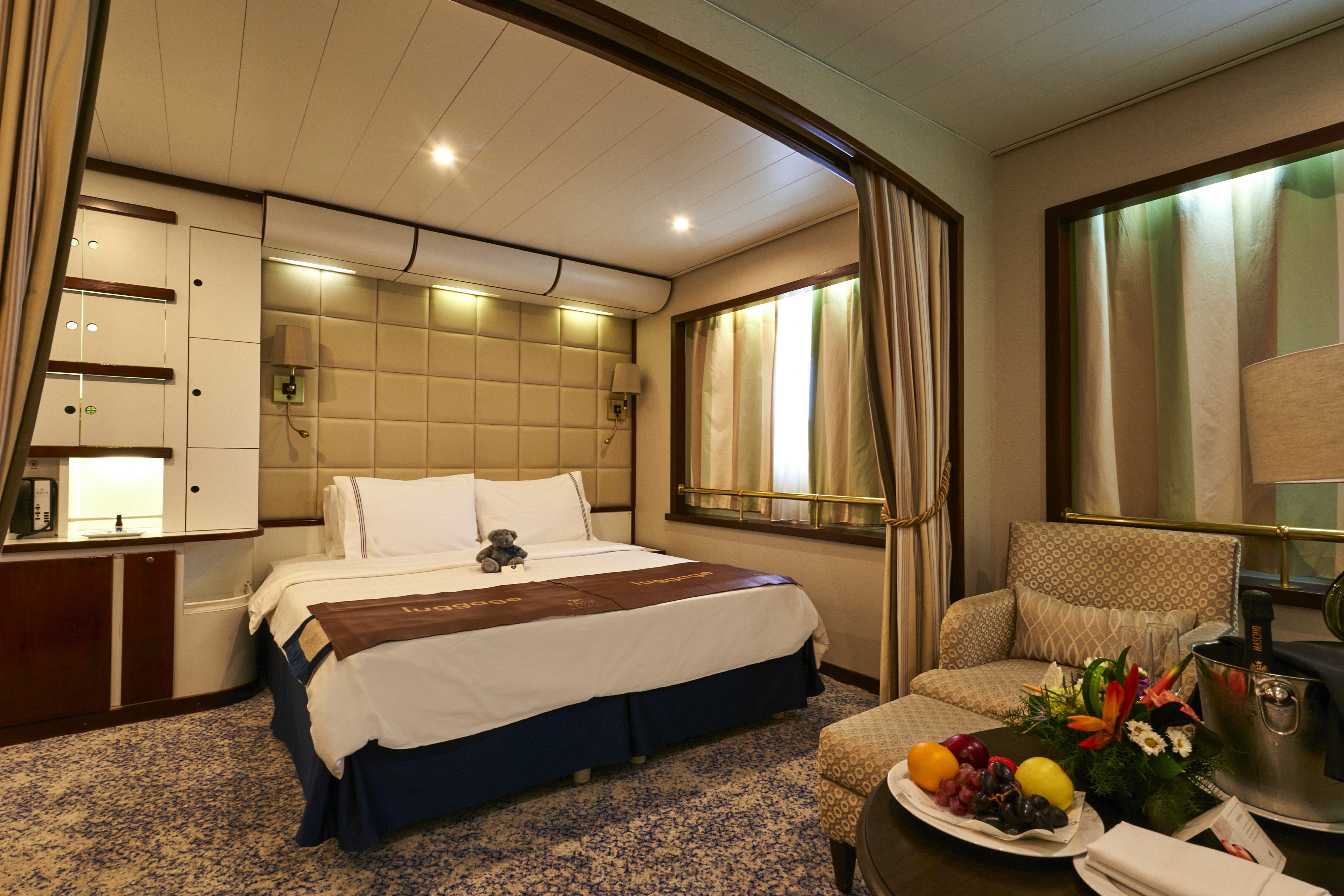
Opulent Bridge Suites
The ultimate in space and style surrounds you in 495 square feet of pure indulgence. Separate bedroom and living room with an in-suite dining area is an invitation to relaxation. And possibly best of all, your expansive bathroom features both a whirlpool spa tub and a massage shower.
All Accommodations Feature
- Queen Size Bed with Luxurious Linens
- Waffle Weave Robe and Slippers
- Fully Stocked Mini Bar/Refrigerator
- Hair Dryers and 110/220 outlets
- Bathroom with granite countertop and shower
- Granite vanity with magnifying mirror
- Safe
- L’Occitane Bath Amenities
- Fresh Fruit
- Wi-Fi access
- Television

Owner's Suite
One of the best secrets in the cruise industry, this unique suite is located directly behind the Bridge. The Owner’s Suite, previously named the Officer’s Suite, is the only public accommodation near the officers’ quarters. Following the renovation, expect an elevated nautical look for true insider-y yacht life in a tucked away location.
All Accommodations Feature
- Queen Size Bed with Luxurious Linens
- Waffle Weave Robe and Slippers
- Fully Stocked Mini Bar/Refrigerator
- Hair Dryers and 110/220 outlets
- Bathroom with granite countertop and shower
- Granite vanity with magnifying mirror
- Safe
- L’Occitane Bath Amenities
- Fresh Fruit
- Wi-Fi access
- Television

Spacious Suites
Joining Windstar’s all-suite, Star Plus yachts in this unique offering, Wind Surf will offer themed Broadmoor and Sea Island Suites, which are inspired by luxury, Five Star sister resorts The Broadmoor in Colorado and Sea Island in Georgia.
With 376 square feet, you’ll find the perfect space for time together – and plenty of room for time to yourself. You’ll even enjoy two full separate bathrooms. All the amenities of the staterooms await you, plus a beautiful sitting area, and two flat-screen television sets.
Broadmoor Suite – Inspired by the design of The Broadmoor, this suite offers a traditional space with classic furniture, floral motifs, white trim with gold finishes, and wide crown moulding. New furnishings and wall sconces have been specially commissioned in the resort’s style. The striking wallpaper used in the suite’s walk-in closet is an exact replica of the wallpaper used throughout The Broadmoor. The resort’s signature carpeting, with shades of light blue, brown, yellow, and gold, was also recreated for the space. Historical black and white images of The Broadmoor will be on display.
Sea Island Suite – This suite will offer a coastal airy space with curved arches, lovely “hardwood” floors, gorgeous inset carpeting, light walls, and white trim with black finishes. New antique-style furnishings and custom wallpapers have been specially commissioned in the resort’s style. You’ll never see a TV at Sea Island (they are all tucked away in cabinets), so you won’t see one in this suite, either. Historical black and white images of Sea Island will be on display.
All Accommodations Feature
- Queen Size Bed with Luxurious Linens
- Waffle Weave Robe and Slippers
- Fully Stocked Mini Bar/Refrigerator
- Hair Dryers and 110/220 outlets
- Bathroom with granite countertop and shower
- Granite vanity with magnifying mirror
- Safe
- L’Occitane Bath Amenities
- Fresh Fruit
- Wi-Fi access
- Television
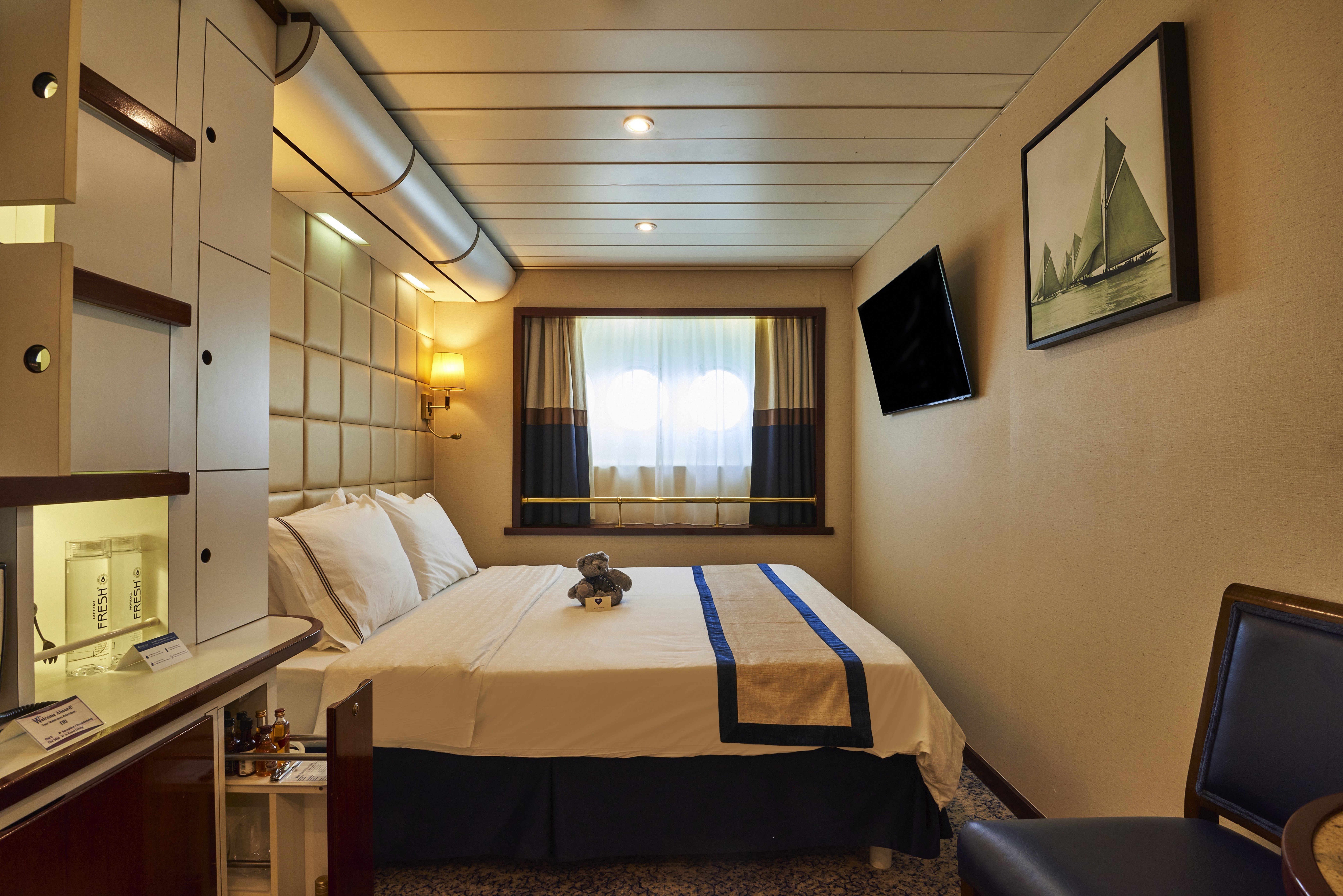
Gracious Staterooms
New connected TVs in all staterooms with the line’s Wayfinder app for finding the ship’s agenda, menus, movies and TV shows, guest accounts and more.
Stylish comfort and ocean views welcome you in 188 square feet of beautifully designed comfort. Your queen bed (which can be separated as twins if you prefer) is swathed in luxurious Egyptian cotton linens. Before or after you enjoy an invigorating massage shower with soothing L’Occitane” bath products, wrap up in your waffle-weave robe and have a snack from the fresh fruit bowl.
All Accommodations Feature
- Queen Size Bed with Luxurious Linens
- Waffle Weave Robe and Slippers
- Fully Stocked Mini Bar/Refrigerator
- Hair Dryers and 110/220 outlets
- Bathroom with granite countertop and shower
- Granite vanity with magnifying mirror
- Safe
- L’Occitane Bath Amenities
- Fresh Fruit
- Wi-Fi access
- Television
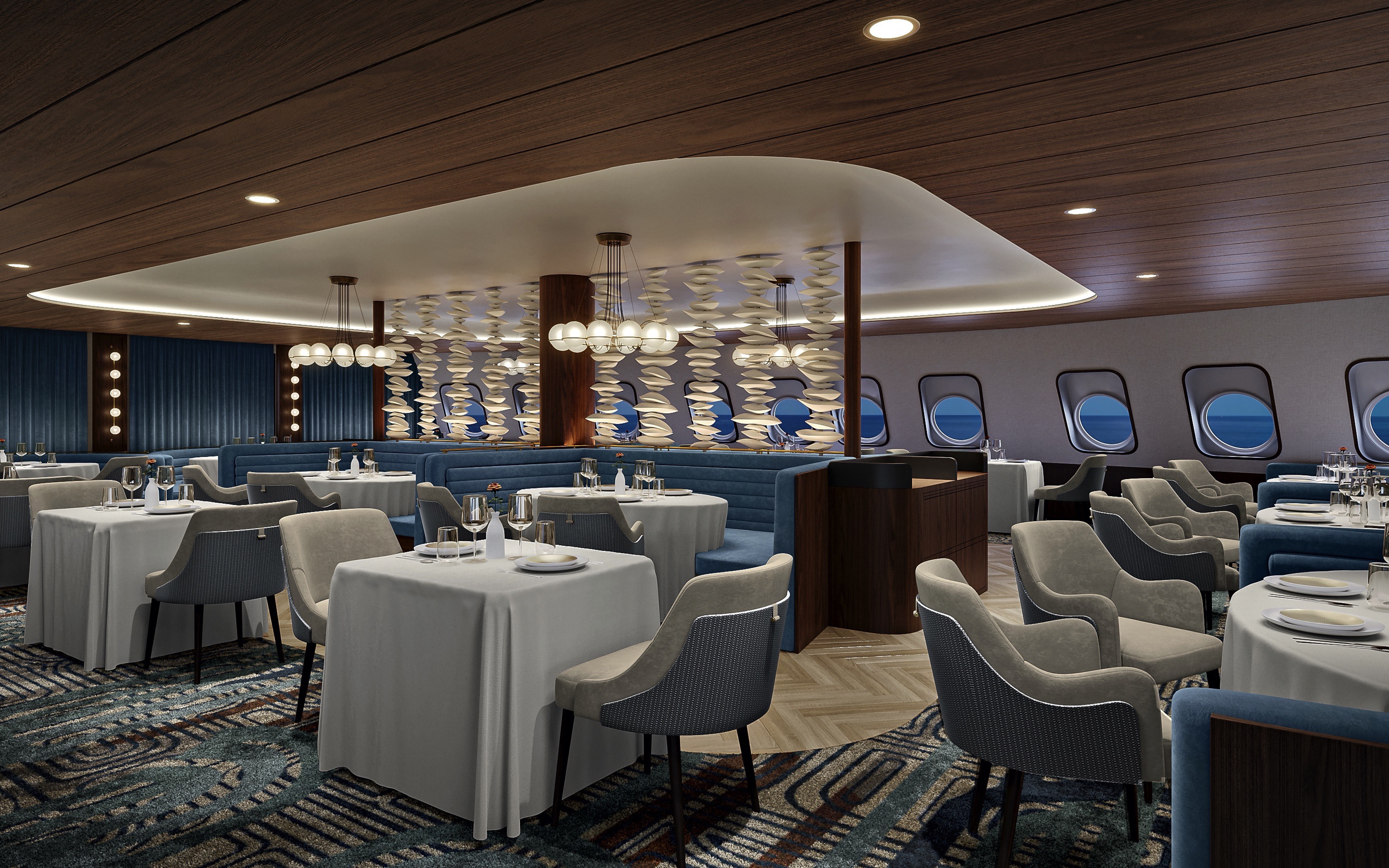
Amphora Restaurant
Wind Surf’s main dining room has been entirely refreshed setting the scene for a timeless dining experience. Amphora’s new design concept draws from elements of the sea, such as pearls, smooth stones, and sea glass, which guests will see integrated into the new architecture and furniture details. The complementing colour tones were inspired by the horizon at sunset. New seating arrangements include curved booths to seat 2-8 people, new larger dining chairs for comfort.

Stella Bistro
Treat your palate to the French-inspired café cuisine of Stella Bistro, Wind Surf’s alternative restaurant. You’ll find delightfully indulgent desserts and a wonderful array of wines specifically paired to the meal. (Wind Surf only)
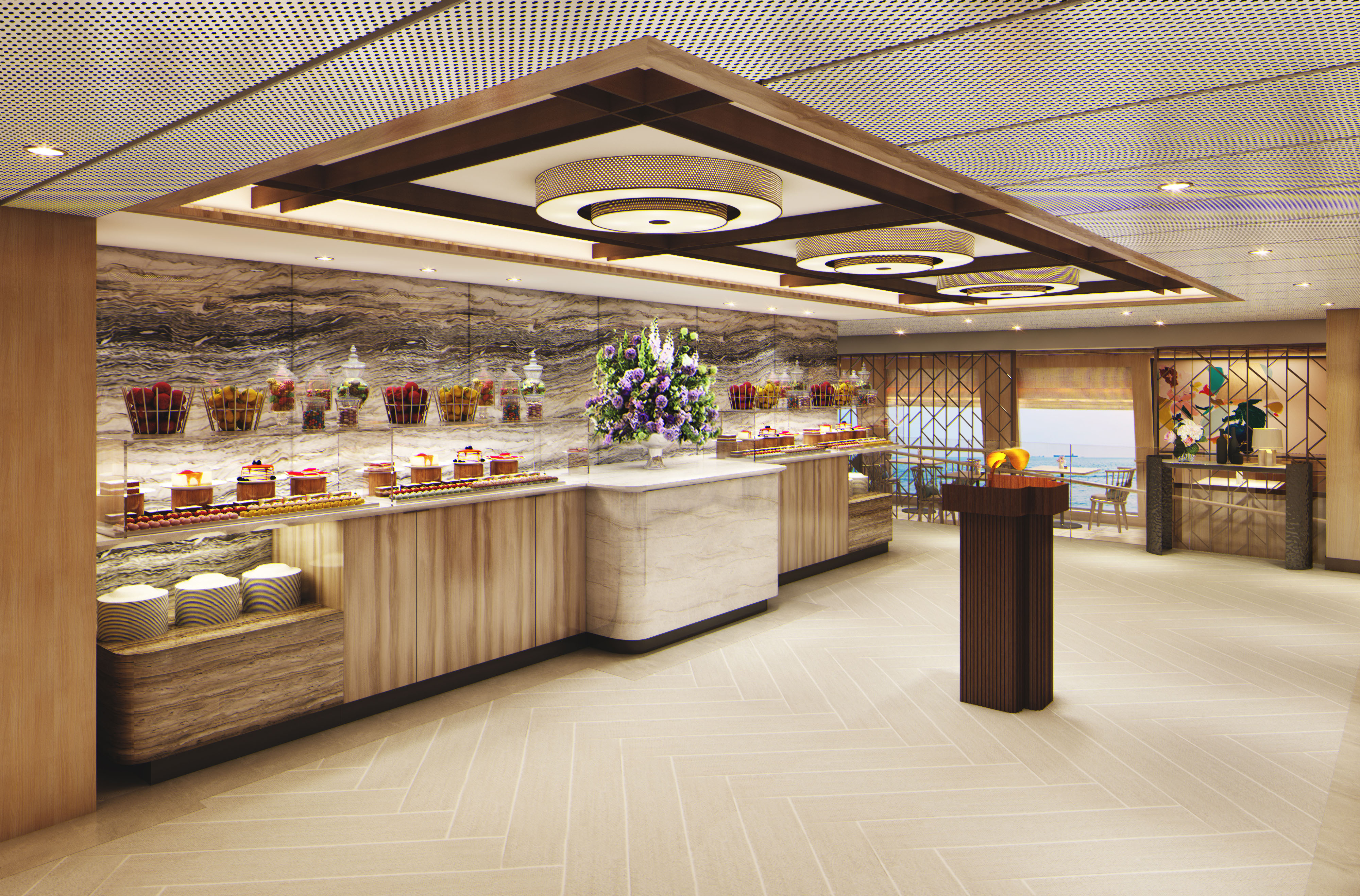
Veranda Restaurant
It’s breakfast alfresco, full service or buffet-style, anytime till 9:30 a.m. No need to hurry. Again, the choices are many in Veranda. Choose the sumptuous, seemingly endless buffet. Or, order from the lunch menu between noon and 2:30 p.m

24-Hour Room Service
Stay in tonight and even order from the main Amphora dining menu.
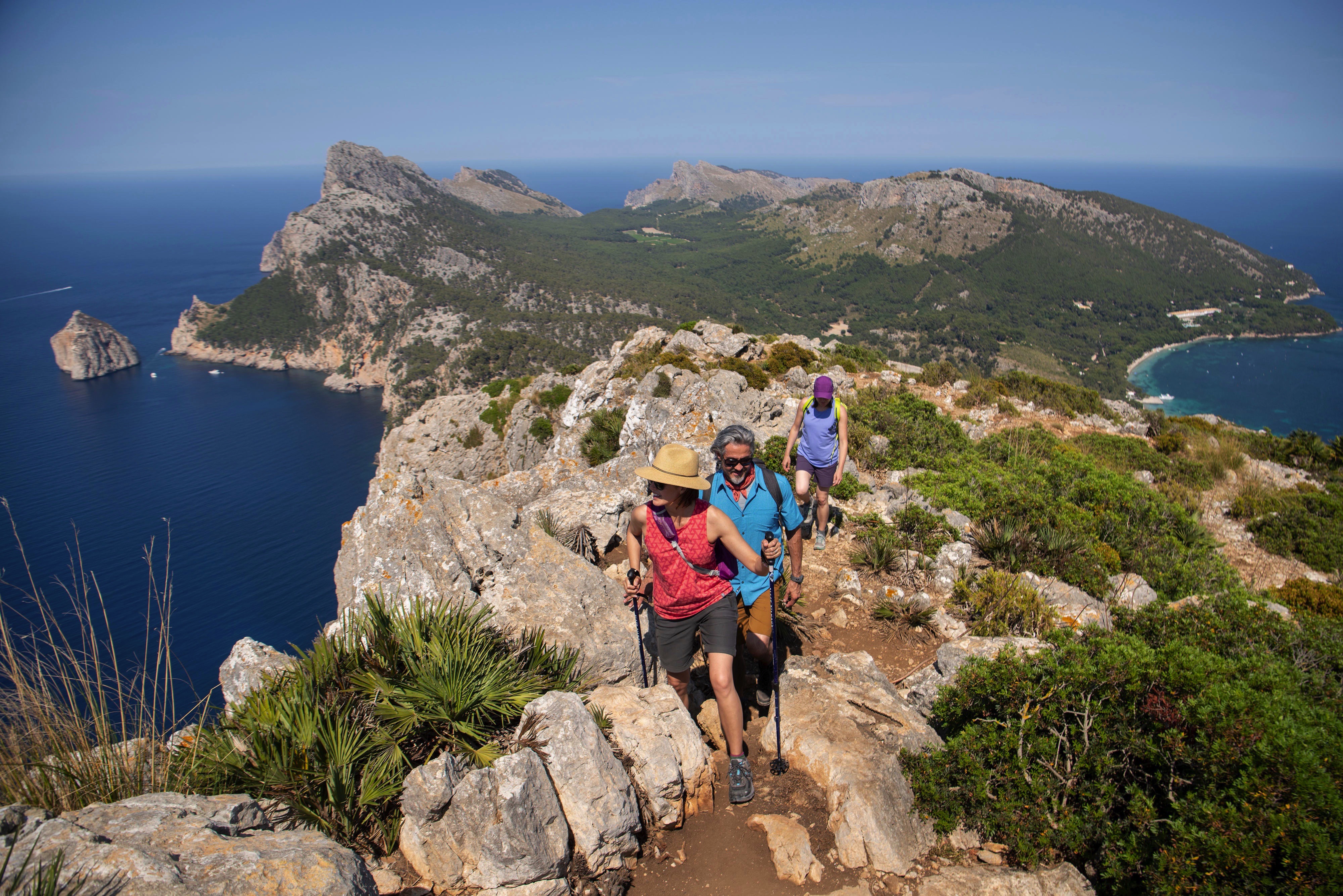
Shore Excursions
The Best On Land Brought To You By The Best At Sea
Choose from over 2,000 one-of-a-kind tours and activities
Get to the heart of local cultures with Windstar shore excursions.
You don’t want to just dip a toe in local culture, you want to dive into the deep end, and that’s exactly what Windstar shore excursions are designed to do. All of our excursions are created to provide authentic local experience – the kind travellers like you are looking for. And with more than 2,000 excursions to choose from, you can experience your destination in whatever way is most meaningful to you. Whether you’re an outdoor enthusiast, a foodie, a history buff or someone who loves to get to know the faces behind the many places we travel.
We make sure the hot springs are hot and the pinot grigio is chilled.
How do we find these authentic experiences, you ask? Our Product Development Team travels to each destination and personally vet each shore excursion to makes sure it makes the grade. (So yes, the Open Course Canopy Challenge in Falmouth Harbour, Antigua? They went on that.) And because we travel in small groups, we can adjust tours in real time based on guest feedback, whether that means finding a different place for lunch, or spending more time at a particularly fascinating historical site. We take the time and make the trip because we want your travels to be unforgettable.
Immersion in regional culture
Local guides share insight into their everyday world, as well as insider highlights that you don’t want to miss. As part of a smaller group, you’re able to bypass long lines, visit places off the beaten path, and get all of your questions personally answered.
Private tours available
Explore at your leisure with a private vehicle, driver, and English-speaking guide. These exclusive tours allow you to customise your time ashore and explore the sites most interesting to you in the comfort and privacy of your own car or van. With your private vehicle, and the personalised attention of your driver and guide, you will have the flexibility and independence to design your own unique tour. This is a great option for families and groups traveling together.
Quality and convenience
Every Windstar excursion meets our high standards of enjoyment, safety, and professionalism. Tour departure times coincide with your ship’s schedule and depart right from the pier. All of our tour operators are fully insured, licensed, and bonded. Our guests consistently rate their shore excursion experiences as excellent.
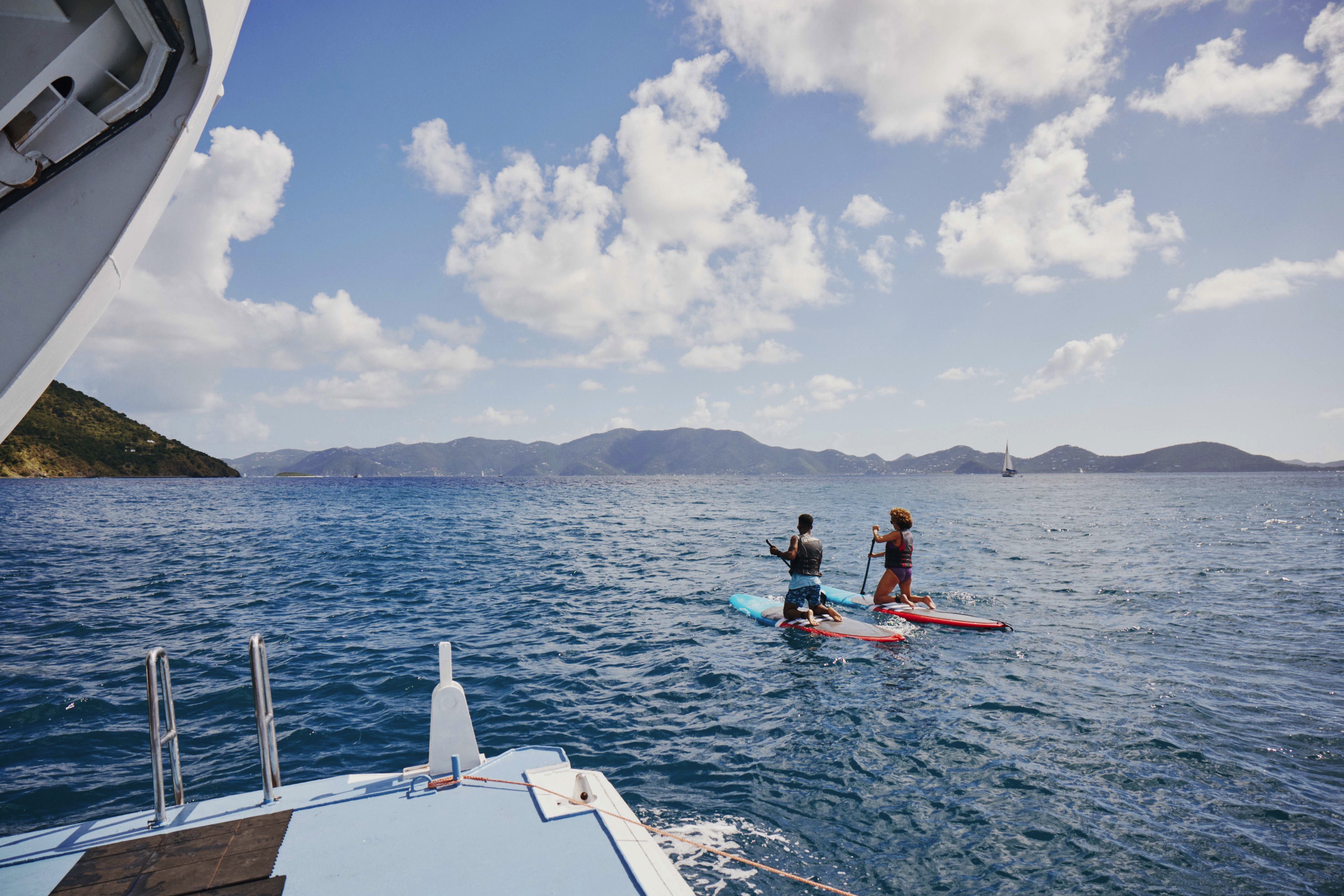
Watersports Platform
Jump In For Fun
A cruise to Tahiti, the Mediterranean or the Caribbean isn’t just about the land. It’s about the sea. That warm, turquoise water is more than willing to answer your question about what to do today, and the phenomenal Watersports Platform on the stern of your Windstar yacht is more than willing to provide the means — no beach required. It’s just one more way our yachts get you closer to your destination.
COMPLIMENTARY WATERSPORTS EQUIPMENT AND ACTIVITIES INCLUDE*:
- Snorkelling gear (a personal custom-fit set for your use throughout your Tahiti cruise and in select Caribbean and Central America destinations)
- Stand-up paddleboards
- Kayaks
- Foam flotation magic carpet
- Water trampoline
- Sailboat

Guest Lectures
On select Windstar voyages, satisfy your curiosity and enhance your understanding of the local culture by listening to our onboard lecturers. We’ve curated a group of speakers designed to bring you an insider’s perspective on a multitude of intriguing topics. Listen raptly as your voyage becomes more than just a vacation – and a thought-provoking exploration of enchanting lands.
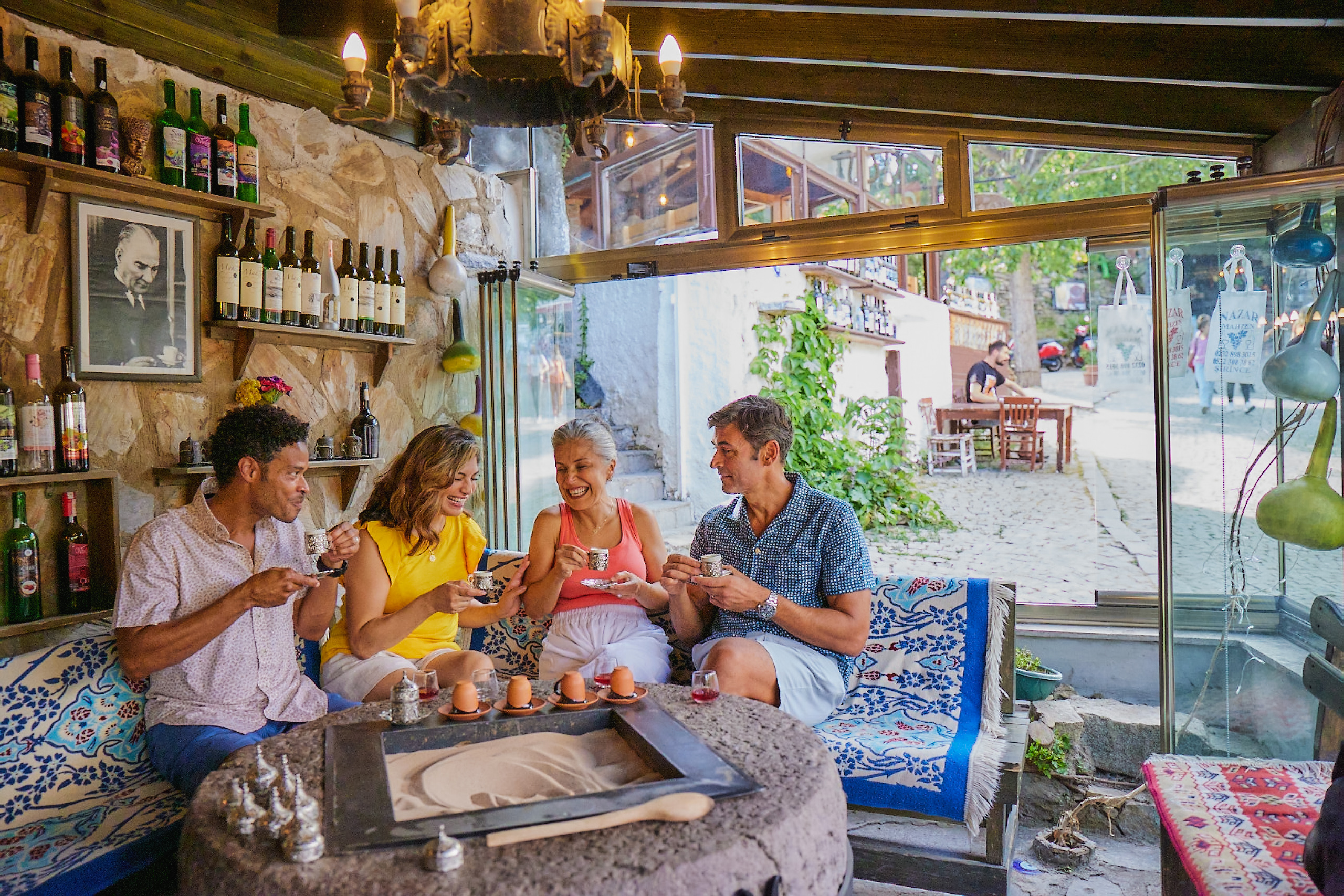
Windstar Signature Expeditions
We’re Taking Travellers to a Different Alaska
Introducing the Windstar Signature Expeditions program. Helmed by a team of on board expedition experts who sail with the cruise the entire time, they’ll provide more insight, understanding, and commentary to show you an Alaska you’ve never seen before. Consisting of naturalists, glaciologists, historians and more, this team of experts will also lead guided tours, sometimes directly from the ship to some of the most remote areas of the Alaskan frontier.
Each once-in-a-lifetime experience will leave you hungry for more of the real flavors of Alaska. Book your Alaska cruise and Signature Expeditions today.
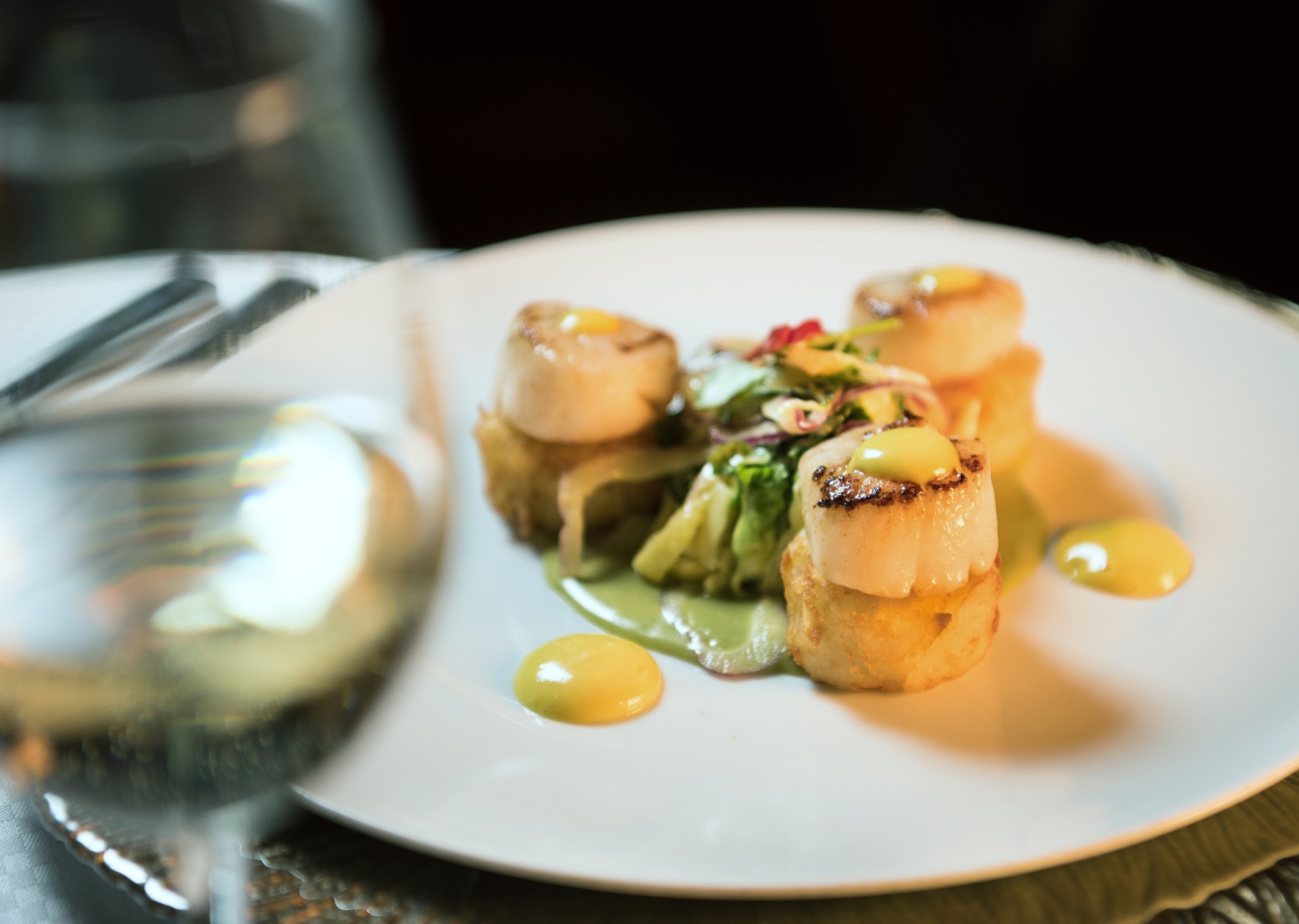
Culinary Demonstrations
Delight your palette with onboard cooking demonstrations featuring James Beard Foundation chef recipes. From wild striped bass with tomato sage “fondue” to lobster risotto, our Windstar chefs will take your taste buds on a journey through local cuisine. For a special tantalising treat, join Windstar on one of our voyages in the James Beard Foundation Culinary Cruise Collection, where a James Beard Foundation chef will show you how to elevate your own culinary skills. It’s a taste of enrichment you’ll never forget.
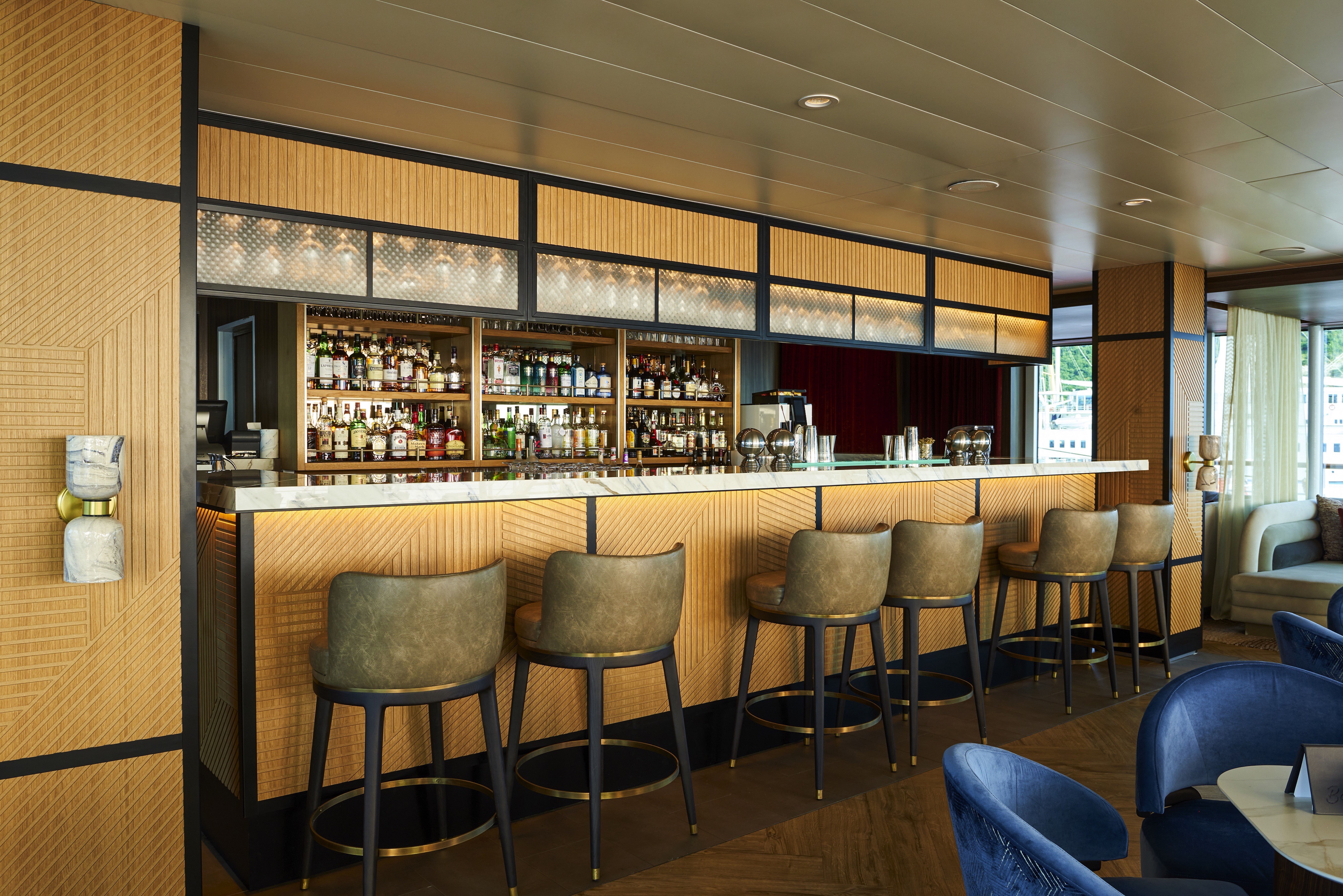
Compass Rose Bar
The ship’s Compass Rose features comfortable, modern décor with pops of blue and orange, a chic bar, and a new multi-purpose stage area ideal for live music and local performances.

Pool Deck & Bar
This space will now maximise Wind Surf’s ocean views and create a more convivial vibe for poolside lounging and top-shelf mixology. Tropical scenes and greenery at the bar pull in a natural, outdoor atmosphere. Soothing natural colours convey a beach scene and new arty tiling on the two whirlpools take the form of ocean waves. Look for a variety of new outdoor furniture as well.

Star Boutique
A larger retail area with upscale details, reminiscent of a luxury brand store’s shopping experience.
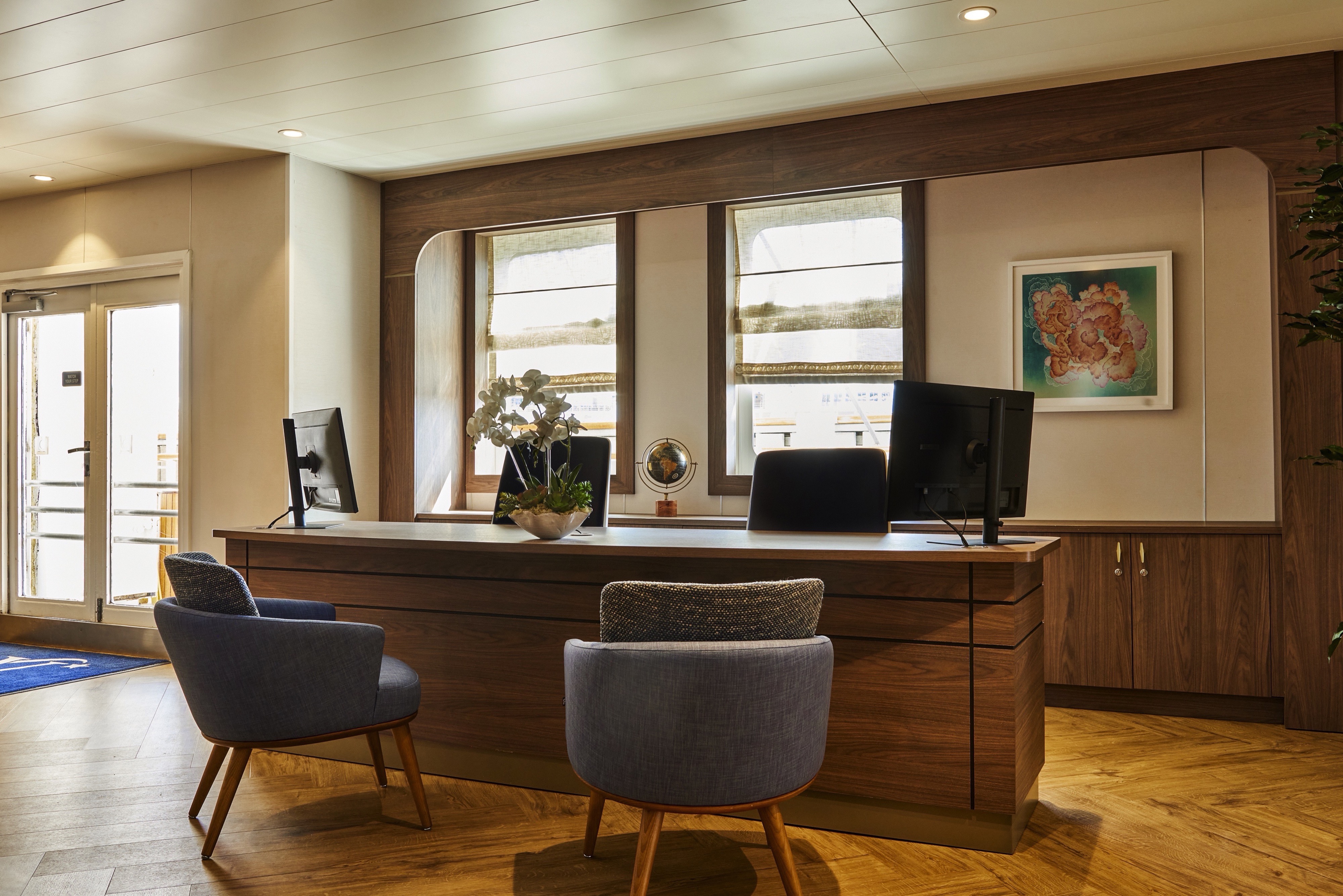
Reception
A new, more welcoming location that’s better able to serve guests with additional seating options, plus an updated and fresh (yet still nautical) vibe akin to a boutique hotel.

Onboard Entertainment
Onboard entertainment facilities include: a casino, a watersports platform, the Compass Rose Cocktail Bar, The Lounge, and The Terrace Bar.
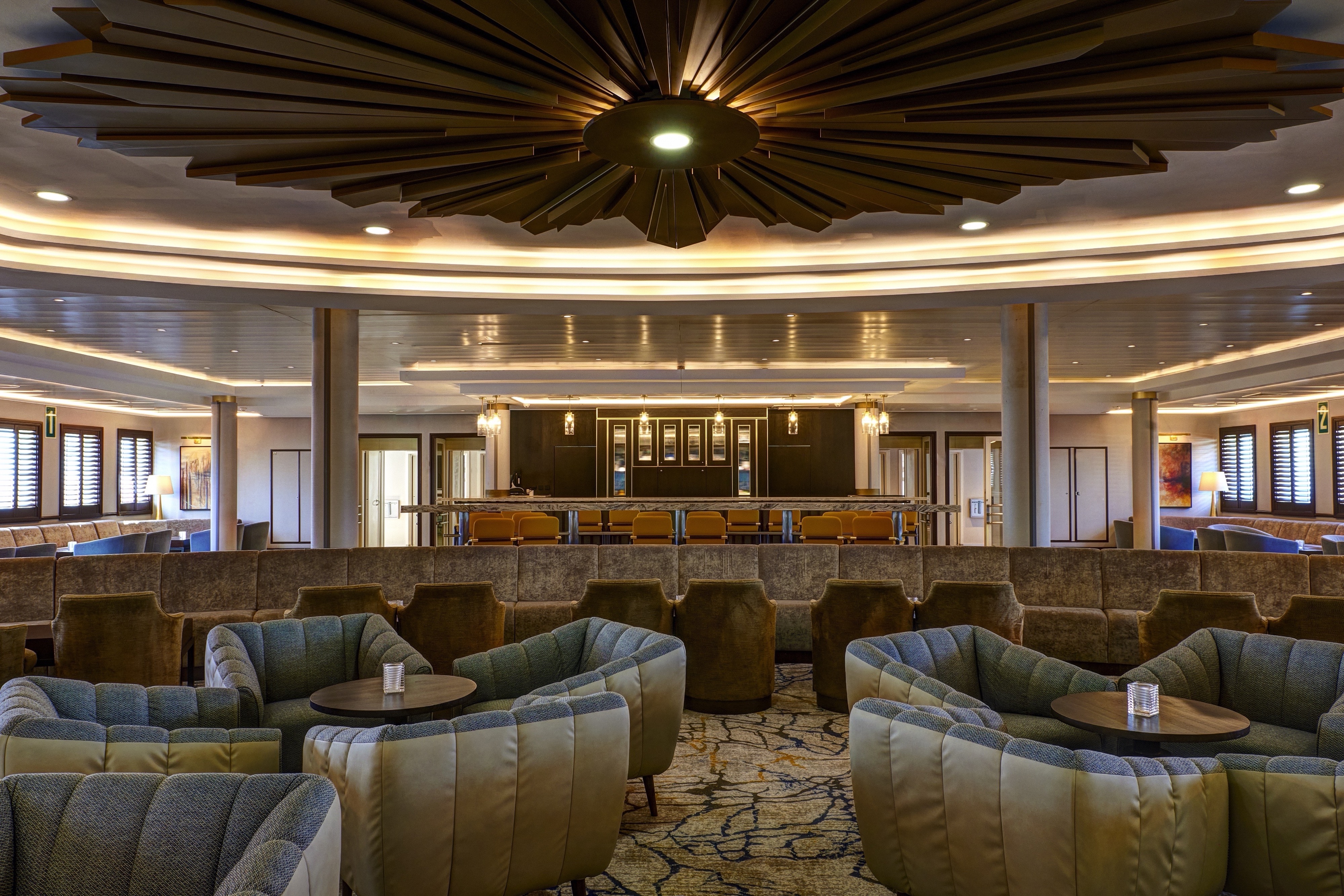
Lounge
An expanded lounge with new lights and sound for upcoming stage performances.
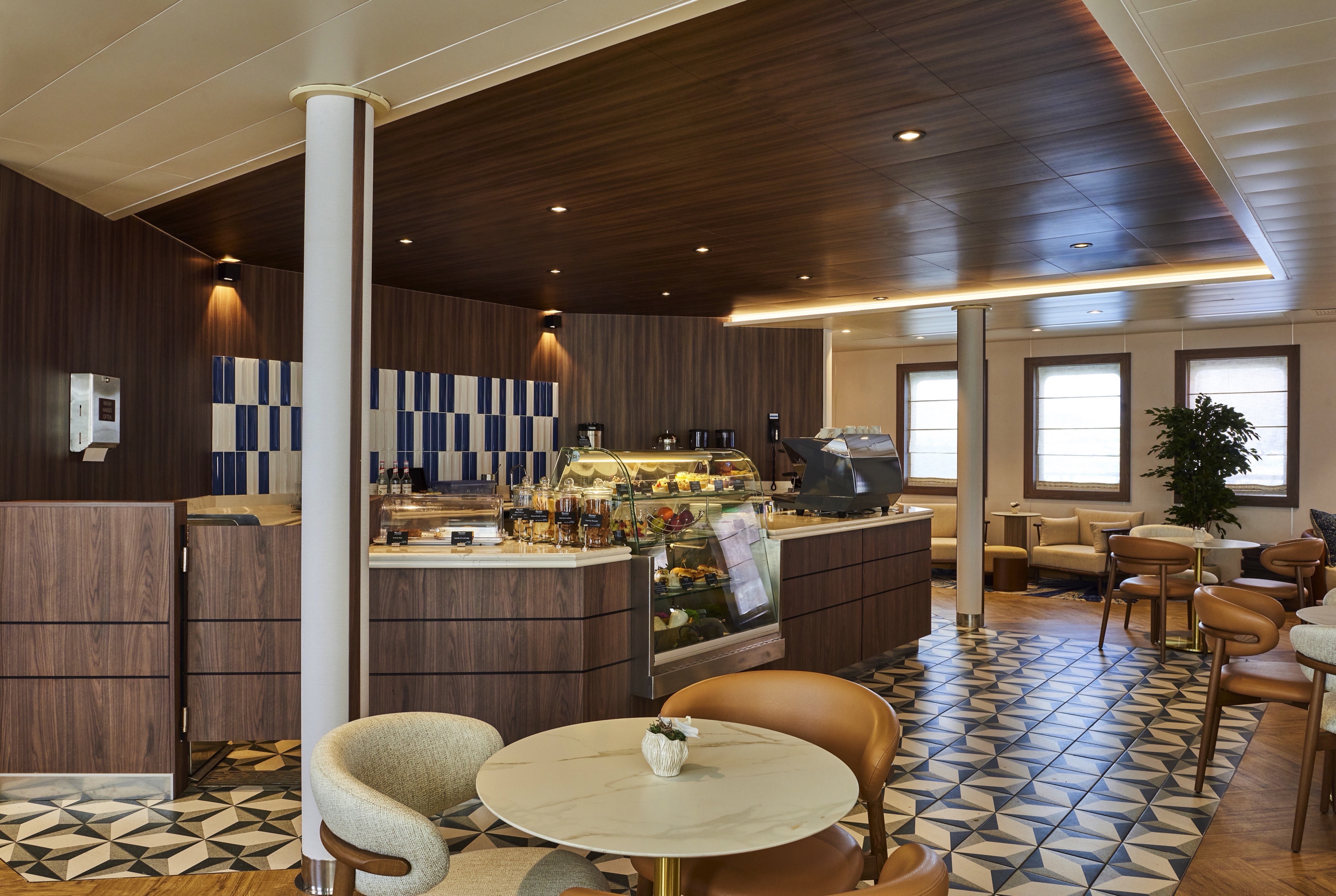
Yacht Club Café
The Yacht Club Café can be found on the Main Deck.

Wine Room
Located on the Main Deck

Bridge
Located on Bridge Deck

Health and Fitness Facilities
Health & Fitness facilities include a Fitness Centre, whirlpool, and swimming pool.

WindSpa
Relax into the destinations you’re visiting at the new World Spa by Windstar, which will offer regional spa treatments, including massage styles like Swedish, Japanese Shiatsu and Hawaiian Lomi Lomi.

Pool Area
Located on the Main Deck
Guests With Disabilities
Windstar does not discriminate against persons on the basis of disability. We seek, to the extent feasible, to accommodate the needs of persons with disabilities. There are no elevators on Wind Star and Wind Spirit nor were the ships originally constructed to be wheelchair accessible. As a result, these ships may be unsuitable for people relying solely on wheelchairs. The other yachts are equipped with elevators, but staterooms on Wind Surf are not wheelchair accessible. Also note, there is no elevator access to board the ship. Star Pride, Star Breeze, and Star Legend have modified wheelchair accessible suites available.
Certain ports require the ship to anchor; in this case guests must be ferried into port. Service Dogs are permitted onboard ships if prior arrangements have been made at time of booking. In limited situations where an individual with a disability would be unable to satisfy certain specified safety and other criteria, even when provided with appropriate auxiliary aids and services, we may find it necessary to ask the individual to make alternative travel arrangements. It is essential that Windstar is notified of any special medical, physical or other requirements you may have at the time of booking. For additional information, please contact accessdesk@windstarcruises.com
Age Restrictions
Windstar Cruises is unable to accommodate children under eight (8) years of age. All Guests under 21 years of age must be accompanied by a parent, guardian or chaperone who is at least 21 years old. Parents, guardians, and chaperones are responsible for overseeing the onboard conduct of minors. Alcoholic beverages will not be served to guests under age 21.
For family groups booking multiple staterooms, the minimum age for at least one person in each stateroom is 18 years of age, provided they are traveling with a parent, guardian or chaperone.
Dress Code
The less you bring the better. We suggest clothes that are light, cool, and made of natural fabrics like cotton and silk. You may wish to bring warmer clothing (layers are best), if you are traveling on an Ocean Crossing or an autumn Mediterranean cruise. Additionally, many guests find it helpful to pack water shoes when visiting Tahiti and other tropical islands as the beaches may have rocks or coral.
The Dress Code – from 7 am – 6 pm guests are welcome to dress as they please with the exception of no swimwear in all public lounges and restaurants and no clothing with offensive language or graphics that distract from the comfort and well-being of others. The general shipboard style is elegant, but relaxed including jeans and Bermuda/ walking shorts.
In the evening – after 6 pm when dining in Amphora, Stella Bistro or Cuadro 44 by Anthony Sasso, the dress code is country club-type clothing. For men – nice slacks, polo shirts, button down shirts, shoes other than athletic shoes. Designer denim jeans without rips or holes or are multi-coloured are also acceptable. Sport coats are optional. Ties are not needed. For women – nice pants, skirts, tops, casual dresses, sundresses, nice sandals or casual shoes and designer denim dress jeans not ripped or multi-coloured or having holes. Blazers are optional.
Premium Beverage Package
While non-alcoholic beverages are complimentary, you may enjoy a pre-dinner cocktail under the setting sun or a champagne toast at the evening Sail Away with our beverage packages for wine, beer, cocktails and more. Zero-proof cocktails are also included with our Captain’s Exclusive and All-In packages. Find the perfect wine pairing with your meal and then end the night sipping scotch as you contemplate the stars.
Topmast Discoveries Beer & Wine Package – $55 per person per day An extensive package of diverse and intriguing wines from traditional European winegrowing terroirs to New World regions. Includes domestic and imported beer and 33 varieties of wine by the glass.
Captain’s Exclusive Beverage Package – $65 per person per day The ultimate beverage package and the perfect way to try new drinks for a bit of added adventure. Includes all domestic and imported beers and 33 varieties of wine/sparkling/champagne by the glass PLUS cordials, liqueurs, apertifs, cocktails and even mini bar items. (Cocktails based on house & select brands)
The All-In Package – From $99 per person per day. Have it all by making it an all-inclusive voyage with Wi-Fi, unlimited beer, wine & cocktails, and gratuities, including the 18% beverage service charge. A convenient bundle that saves time and money, pays most of your expenses upfront and avoids the European VA Tax when pre-purchased. The All-In Package is sold per person and must be purchased up to 5 days prior to departure at $99. On board the All-In Package can be purchased for $99.
The Topmast, Captain’s Exclusive, and All-In Packages are sold per person and must be purchased in advance or during the first 2 days of your cruise and for the full duration of the cruise. Prices for the Topmast and Captain’s Exclusive Packages do not include the standard 18% beverage service charge. Package prices are inclusive of applicable taxes. The minimum drinking age aboard Windstar Cruises is 21 years old.
Laundry Service
Laundry service is provided on board at a nominal charge. Dry cleaning is not available. Laundry Service Packages must be added by the first day of the cruise and will be priced by the total number of cruise days. Pricing is inclusive of applicable taxes.
Your Windstar Voyage Includes
- All meals in all venues at all times, including room service menu available 24 hours
- All non-alcoholic beverages, including cappuccino, espresso, and other specialty non-alcoholic drinks
- Welcome cocktails at reception
- All onboard entertainment
- Unlimited use of Fitness Center
- Unlimited use of all water sports equipment
- Informative nightly port talks and destination briefings
Food Allergies and Special Dietary Needs
Here at Windstar we are committed to offering our guests healthy food selections. We offer vegetarian selections and lighter fare options, seeking to provide the freshest, top quality foods handled with the utmost care. If you have food allergies or special dietary needs, there are several ways to notify us prior to boarding the ship.
It’s important to let us know about your special request when you book your cruise to help us plan and prepare for your meals. Your travel professional will enter this information in Special Requests. It is then noted on your booking and your ship will be notified, although it will not appear on your invoice or in My Windstar.
Special Request Dietary Needs include:
- Alcohol Free
- Celiac
- Dairy Free
- Diabetic – Diet Controlled
- Diabetic – Insulin Controlled
- Food Allergy
- Gluten Free
- Lactose Intolerant
- Low Carbohydrate
- Low Cholesterol
- Low Protein
- Low Sodium
- Other Dietary
- Sugar Free
- Vegan
- Vegetarian
- Wheat Free Diet
Unfortunately we are unable to accommodate Kosher or Halal meals. If you have specific dietary needs– such as – lactose intolerant requiring almond milk – please complete a Special Requirements Information Form. Return this information via:
- Mail to Windstar Vacation Planning at 8400 NW 36th St. Suite 520, Miami, FL U.S.A. 33166
- Fax to 786-685-3089
- Call 1-888-502-9621 to speak with a Vacation Planner in person
- Send an email to info@windstarcruises.com
When you embark the ship please feel free to ask to speak with the Executive Chef about your specific request.
If you have any additional questions or concerns please call us during business hours at 1-888-502-9621.
Smoking Policy
Smoking or vaping is not permitted in any of the staterooms, suites, or public spaces, including all restaurants and corridors. Smoking and vaping is permitted on the outside decks in designated smoking areas only. Smoking cigars is permitted in a specific designated area on each yacht, however, only sold on board the Cigar Room of Wind Surf.
Internet/Wifi Access
Communications At Sea
EMAIL – Windstar Cruises offers full internet capabilities, depending on course and position of the ship, as well as wireless internet service on all ships. Wi-Fi access is possible in most public areas, staterooms, and suites.
POSTAL MAIL – You can receive mail while on board, but guests are discouraged from relying on postal mail.. Please call a Vacation Planner at 1-888-502-9621 for information on shipping options and lead times to ensure your mail arrives in time for your visit to a given port of call.
Phone & Fax Communications
Guests on board may make phone calls from their stateroom or suite at a cost of $7.95 per minute.
Emergency Phone Numbers:
During regular business hours please call 1-888-502-9621 or 206-733-2704 (8:00 am to 10:00 pm Monday through Friday; 9:00 am to 7:30 pm Saturday; 10:00 am to 6:30 pm Eastern Time). Outside of these hours and during holidays, call 206-733-2991 (This number is for emergency use only; please do not call unless you are experiencing an emergency of an urgent nature).
INTERNET ACCESS – As part of our onboard service we offer internet access on our ships. We recently modified our internet usage packages from minutes to the amount of data used.
How does internet access at home differ from access at sea?
As with all ship communications, the internet service is operated through satellites. While you are most likely used to a fast internet connection at home, in hotels or other local Wi-Fi spots, internet at sea can be slow, and at times, disruptive. The only option available is satellite connection, which is costly and limits the amount of data used. The connection is also influenced by weather, the movement of the ship, and in the case of our sailing ships, blockage from our sails passing in front of the satellite dish.
It is not recommended for downloading movies or large files due to system speed. In some areas the service can be interrupted by weather or the ship’s position. We recommend that guests use the service only for emails or small files.
Why did the Internet Usage Plan change from minutes to megabytes?
Windstar modified the Internet Usage Plan in order to provide guests with the ability to access the same number of sites and/or read the same number of emails, regardless of connection speed. The previous plan was based on the number of minutes the guest was accessing the internet, regardless of connection speed. At times, factors like bad weather, ship speed, overcast conditions, all contributed to slow and/or disrupted connections.
What is a megabyte (MB)?
Any file, whether it’s a spreadsheet, word document, or email, takes up electronic storage space, otherwise known as bytes. The larger the file, the greater the number of bytes. The standard increment of measurement is bytes, kilobytes (1000 bytes), megabytes (1,000,000 bytes) and gigabytes (1,000,000,000, bytes).
As a frame of reference, an 80-word email is around 10 kilobytes, while a typical web page is approximately 1 megabyte.
What type of Internet Usage Plans are available?
The Email Plan $60 – This plan gives you 200 MB of data to use during your cruise. This plan is recommended for people who will be checking email and doing very limited browsing. The estimated minutes range from 15 to 60.
The Surfing Plan $120 – This plan gives you 500 MB of data to use for additional browsing and small file transfers (such as posting pictures to a social media site). The estimated minutes range from 90 to 360 (approximately 5 hours).
The Ultimate Plan – Unlimited Internet Package
- -7 Day Cost $245
- -8 Day Cost $280
- -9 Day Cost $315
- -10 Day Cost $350
- -11 Day Cost $385
- -14 Day Cost $490
- -15 Day Cost $525
This plan gives you unlimited internet access. You have no worries about how much time you spend on the internet.
How can I get internet access on board?
Guests can purchase Internet Usage Plans prior to their cruise through a Vacation Planner or on board at Reception. These plans can be used on personal laptops or smart devises that are Wi-Fi enabled.
* Please Note: All packages only allow for one device at a time to be connected to the internet.
Please contact a Vacation Planner if you have questions.
Medical Facilities
A doctor and limited medical facilities are available on board. However, if you take special medications, please bring an adequate supply with you together with a copy of the prescription from your doctor; it may not be available on board. Medical services and all medicines (except acetaminophen, aspirin, and seasickness pills) dispensed by the ship’s doctor will be charged to your onboard account. If you become ill during the voyage and the physician is unable to care for your needs on board, you will be transferred to medical facilities on shore. Shoreside medical care and/or evacuation are not charged to your onboard account. You will be responsible for paying all of these charges.
If you will require a special medical apparatus or assistance on board or have any special medical, physical or other requirements, please contact our Vacation Planners Department at 1-888-502-9621. Due to limited medical facilities, we will not accept reservations for children under 8 years of age or women who are 24 or more weeks pregnant at the time their travel with Windstar concludes.

Star Deck
- Stella Bistro
- Veranda/Candles
- Fitness Centre
- Terrace Bar

Bridge Deck
- Bridge
- World Spa by Windstar
- Compass Rose Bar
- Owner’s Suite
- Broadmoor Suite
- Sea Island Suite

Main Deck
- Amphora Restaurant
- Amphora Wine Room
- Lounge
- Reception
- Yacht Club Café
- Cruise Consultant Desk
- Destination Desk
- Star Boutique
- Pool / Pool Bar
- Whirlpools

Deck Three
- Suites
- TX Staterooms

Deck Two
- Watersports Platform
- A Staterooms
- AX Staterooms

Deck One
- BX Staterooms
- B Staterooms
- Medical Facility

